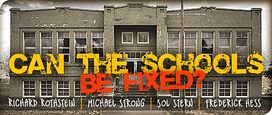Michael Strong and Richard Rothstein have more in common than they are ever likely to acknowledge. Each of them seems to have largely given up on the prospect of significant achievement gains for disadvantaged children within the nation’s existing education system. Instead of offering a practical answer to the forum’s question — “Can the Schools Be Fixed?” — Strong and Rothstein propose education utopias that just happen to coincide with their broader political beliefs.
Michael Strong assures us that “Once we have a national market in education … we will gradually see larger scale improvements in adolescent well-being, and as rates of drug and alcohol use, risky sex, depression, suicide, homicide, and accidents decline, we will also see more interest in academics and greater improvements in test scores.” (Will teenagers still have to worry about acne?) Moreover, Strong assures us that charter school enrollment is going to take off in the next twenty years and those school districts that don’t jump on the bandwagon are going to see no improvement in student outcomes.
I am impressed with Strong’s confidence in his predictive powers, but until he shows us some evidence on the ground I think I will stick with our imperfect system and place my bets on the kinds of changes called for in A Nation at Risk — for example, restoring a content-based curriculum and maintaining high academic standards and expectations. For all of its faults, “A Nation at Risk” was mostly right about the collapse of expectations in the schools and in spotting the decline in achievement levels of American students. It was prescient in calling for restoring an academic curriculum. Such mundane reforms helped bring about the “Massachusetts Miracle.” With no vouchers and very few charters in the state, Massachusetts students nevertheless surged to first in the nation in fourth and eighth reading and math on the NAEP tests. (See my City Journal article, “School Choice Isn’t Enough.”)
In his current response, Richard Rothstein says that I failed to “comprehend” his argument about what we can expect from the existing public schools. He also claims that I “caricatured” his position by suggesting there were “two Rothsteins.” I will admit to indulging in a bit of hyperbole for emphasis. My concern was that Rothstein was being slippery in simultaneously giving the schools credit for any achievement gains, but then absolving those same schools whenever it became clear that student achievement, particularly in the inner cities, was still appallingly low. Now, given a chance to explain this conveniently shifting perspective, he resorts to banality: “Schools are neither fully responsible, nor fully free from responsibility, for student successes and failures. A strategy to substantially improve student achievement, both for middle and lower-class children, will require improvement in both schools and in out-of-school institutions.” But Rothstein doesn’t say when he would apply the “not fully responsible” standard to schools and when he would grant that schools are responsible for student failure. His standard is a constantly moving target.
Moreover Rothstein hasn’t even told us which in-school improvements he thinks should be part of the strategy for raising student achievement. For example, is he in favor of the federal Reading First reading program which encourages scientifically based reading instruction in the early grades? How does he feel about the fact that the Democrats in Congress (his party, I assume) irresponsibly cut this program that was working to raise reading achievement for disadvantaged inner city students?
By contrast, Rothstein gets very specific, but also very utopian, when it comes to telling us which “out-of-school” social and economic changes will bring about higher academic improvement. He wants universal health care for all children, Section 8 housing vouchers for their families, raising the minimum wage, unionizing maids, and many other social and economic interventions. But even if America experiences the political earthquake that might make such changes possible, how does Rothstein know that his very expensive interventions will even work to bring about significant achievement gains? Certainly our past experience with War on Poverty programs is not very reassuring in this regard. In any event, and while he’s waiting for lefty in the political arena, shouldn’t Rothstein be putting some effort into rallying support for instructional strategies that have been proven through scientific research to bring about significant improvement for poor children?
Dr. Reid Lyon, who headed two decades of NIH-sponsored research in reading science, has said that if urban school districts were guided by the NIH findings in selecting programs for the classroom, the black-white achievement gap in reading could be substantially narrowed. I would put my bet on that strategy, rather than either Michael Strong’s free market utopia or Richard Rothstein’s social welfare utopia.

